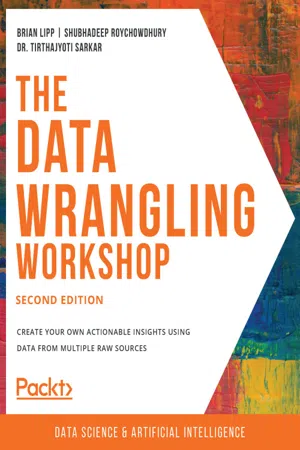
- 576 pages
- English
- ePUB (mobile friendly)
- Available on iOS & Android
The Data Wrangling Workshop
About this book
A beginner's guide to simplifying Extract, Transform, Load (ETL) processes with the help of hands-on tips, tricks, and best practices, in a fun and interactive wayKey Features• Explore data wrangling with the help of real-world examples and business use cases• Study various ways to extract the most value from your data in minimal time• Boost your knowledge with bonus topics, such as random data generation and data integrity checksBook DescriptionWhile a huge amount of data is readily available to us, it is not useful in its raw form. For data to be meaningful, it must be curated and refined.If you're a beginner, then The Data Wrangling Workshop will help to break down the process for you. You'll start with the basics and build your knowledge, progressing from the core aspects behind data wrangling, to using the most popular tools and techniques.This book starts by showing you how to work with data structures using Python. Through examples and activities, you'll understand why you should stay away from traditional methods of data cleaning used in other languages and take advantage of the specialized pre-built routines in Python. Later, you'll learn how to use the same Python backend to extract and transform data from an array of sources, including the internet, large database vaults, and Excel financial tables. To help you prepare for more challenging scenarios, the book teaches you how to handle missing or incorrect data, and reformat it based on the requirements from your downstream analytics tool.By the end of this book, you will have developed a solid understanding of how to perform data wrangling with Python, and learned several techniques and best practices to extract, clean, transform, and format your data efficiently, from a diverse array of sources.What you will learn• Get to grips with the fundamentals of data wrangling• Understand how to model data with random data generation and data integrity checks• Discover how to examine data with descriptive statistics and plotting techniques• Explore how to search and retrieve information with regular expressions• Delve into commonly-used Python data science libraries• Become well-versed with how to handle and compensate for missing dataWho this book is forThe Data Wrangling Workshop is designed for developers, data analysts, and business analysts who are looking to pursue a career as a full-fledged data scientist or analytics expert. Although this book is for beginners who want to start data wrangling, prior working knowledge of the Python programming language is necessary to easily grasp the concepts covered here. It will also help to have a rudimentary knowledge of relational databases and SQL.
Frequently asked questions
- Essential is ideal for learners and professionals who enjoy exploring a wide range of subjects. Access the Essential Library with 800,000+ trusted titles and best-sellers across business, personal growth, and the humanities. Includes unlimited reading time and Standard Read Aloud voice.
- Complete: Perfect for advanced learners and researchers needing full, unrestricted access. Unlock 1.4M+ books across hundreds of subjects, including academic and specialized titles. The Complete Plan also includes advanced features like Premium Read Aloud and Research Assistant.
Please note we cannot support devices running on iOS 13 and Android 7 or earlier. Learn more about using the app.
Information
1. Introduction to Data Wrangling with Python
Introduction
Importance of Data Wrangling
- Scraping raw data from multiple sources (including web and database tables)
- Imputing (replacing missing data using various techniques), formatting, and transforming – basically making it ready to be used in the modeling process (such as advanced machine learning)
- Handling read/write errors
- Detecting outliers
- Performing quick visualizations (plotting) and basic statistical analysis to judge the quality of formatted data

Table of contents
- The Data Wrangling Workshop
- Preface
- 1. Introduction to Data Wrangling with Python
- 2. Advanced Operations on Built-In Data Structures
- 3. Introduction to NumPy, Pandas, and Matplotlib
- 4. A Deep Dive into Data Wrangling with Python
- 5. Getting Comfortable with Different Kinds of Data Sources
- 6. Learning the Hidden Secrets of Data Wrangling
- 7. Advanced Web Scraping and Data Gathering
- 8. RDBMS and SQL
- 9. Applications in Business Use Cases and Conclusion of the Course
- Appendix